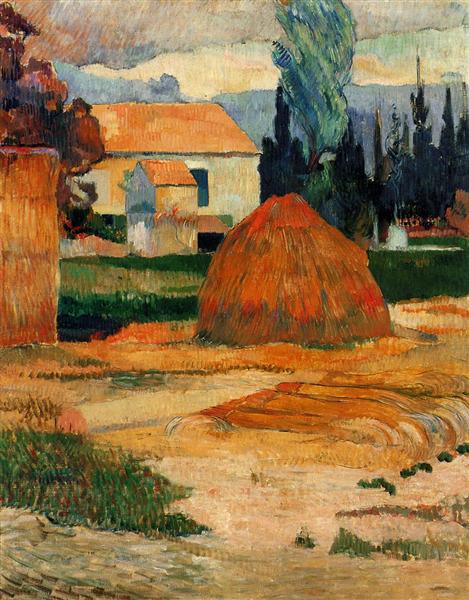Beschreibung
Paul Gauguin's painting "Landscape Near Arles" (1888) is a fascinating testament to his artistic quest in the south of France, during his time in Arles, where he settled in the hope of creating a kind of artistic community. In this work, Gauguin moves away from traditional realism and into a more personal and symbolic approach to landscape, a style that would begin to define him in his later years.
The painting presents a rural landscape characterized by a vibrant palette and a structured composition that evokes both the light and warmth of the Provençal environment. Through his masterful use of color, Gauguin introduces a series of intense hues. Yellow, green, and blue intertwine in a visual dance that not only replicates the surrounding nature, but also conveys a deep, subjective emotion. This use of color is a demonstration of his relationship with Post-Impressionism, where color is used as a means to express feelings and sensations, beyond mere visual representation.
The landscape is composed of well-defined areas, where natural elements are organized with a clarity that recalls the simplicity of the contours. The countryside, represented by a vast plot of land that extends towards the horizon, is interrupted by clayey traces that suggest paths or crops. The shadows and lights of the work, applied in expressive brushstrokes, delineate the time and the hour of the day in which the scene is represented. Above, a clear blue sky contrasts with the warm tones of the countryside, generating a calm and contemplative atmosphere.
Although there are no visible human characters in this work, the absence of figures adds a layer of introspection and allows the viewer to reflect on the connection between man and nature. This figurative silence unites the scene with the viewer, who becomes the witness of the sublime beauty of the rural landscape. Gauguin, throughout his career, experimented with the presence of the human in his works, but here it is the landscape that takes center stage, even in the absence of human figures.
This painting also falls within a transitional period in Gauguin's work, where art becomes a vehicle to express not only external reality, but his own internal reality. This landscape moves away from the more naturalistic approach of his contemporaries, moving closer to an emotional, symbolic and personal interpretation of what he observes. In this sense, "Landscape Near Arles" can be compared to other works of the Post-Impressionist movement that explore the use of color and form not only as representations of nature, but also as expressions of personal experience.
Gauguin, who would become known for his fascination with primitive culture and his creative use of form and colour, found in this landscape a synthesis of his artistic vision at this stage of his career. The work done in Arles became a basis for his later explorations in Tahiti and elsewhere, where he would continue to expand these concepts by interweaving nature with his own reflections on life, culture and a sense of belonging.
"Landscape Near Arles" is a pivotal work that, while often overshadowed by his other, more famous creations, reveals the essence of Gauguin's quest to capture the beauty of the world around him in a unique and deeply personal way. This painting is not only a landscape, but a portal into understanding the perspective of an artist who dreamed of a world where art and nature coexisted in perfect harmony.
KUADROS ©, a famous painting on your wall.
Hand-made oil painting reproductions, with the quality of professional artists and the distinctive seal of KUADROS ©.
Painting reproduction service with satisfaction guarantee. If you are not completely satisfied with the replica of your painting, we will refund 100% of your money.

